There’s about 45 seconds left in the first half, and I’m trying to find a way to extend my four-point lead against the Wyoming Cowboys. I’m playing a night game with the East Carolina Pirates, and it appears that the crowd at Dowdy-Ficklen Stadium is jam-packed and has been pregaming all afternoon. Although I’ve logged around 20 hours of playtime these past few days, I still find myself occasionally pausing — even during dramatic moments like this, when I’d normally be locked in and focused on my playcalling.
Holy cow, this is real.
After a decadelong wait between college football video games, I think I can be forgiven for occasionally needing to take a moment and pinch myself. But yes, EA Sports College Football 25 is real. Perhaps the most real it’s ever been, now that the game not only includes real schools, real stadiums, real broadcasters, and the real College Football Playoff… but, for the first time ever, real players.
And EA didn’t just include household names like Texas quarterback Quinn Ewers, Ohio State safety Caleb Downs, or Missouri wideout Luther Burden III — nearly everybody is here. My digital ECU quarterback is the real Jake Garcia, handing off to the real Rahjai Harris. They’re both trying to evade digital Wyoming defensive tackles Ben Florentine and Jordan Bertagnole, who are real dudes who play for the Cowboys. All in all, Electronic Arts paid for the real licenses to over 11,000 college athletes, in what EA Tiburon developers claim is the largest depiction of real people in a video game… maybe ever. Certainly in a sports video game.
For years, EA couldn’t pay the athletes, which is why older editions of NCAA Football had rosters full of players with names like QB #15 and RB #3 — players who just so happened to closely resemble the real, and uncompensated, athletes. Eventually, the athletes sued, EA paid back damages, schools pulled their licenses, and the franchise was shelved.
But now, the NCAA has finally thrown out its outdated notions of amateurism, and athletes can be compensated not just for their digital likenesses in video games, but for all manner of other commercial activities, paving the way for EA’s college football video game franchise to return.
Is it a perfect college football video game? No. But it’s one that was clearly made by college football fans, for college football fans. It’s a game that was worth the wait.
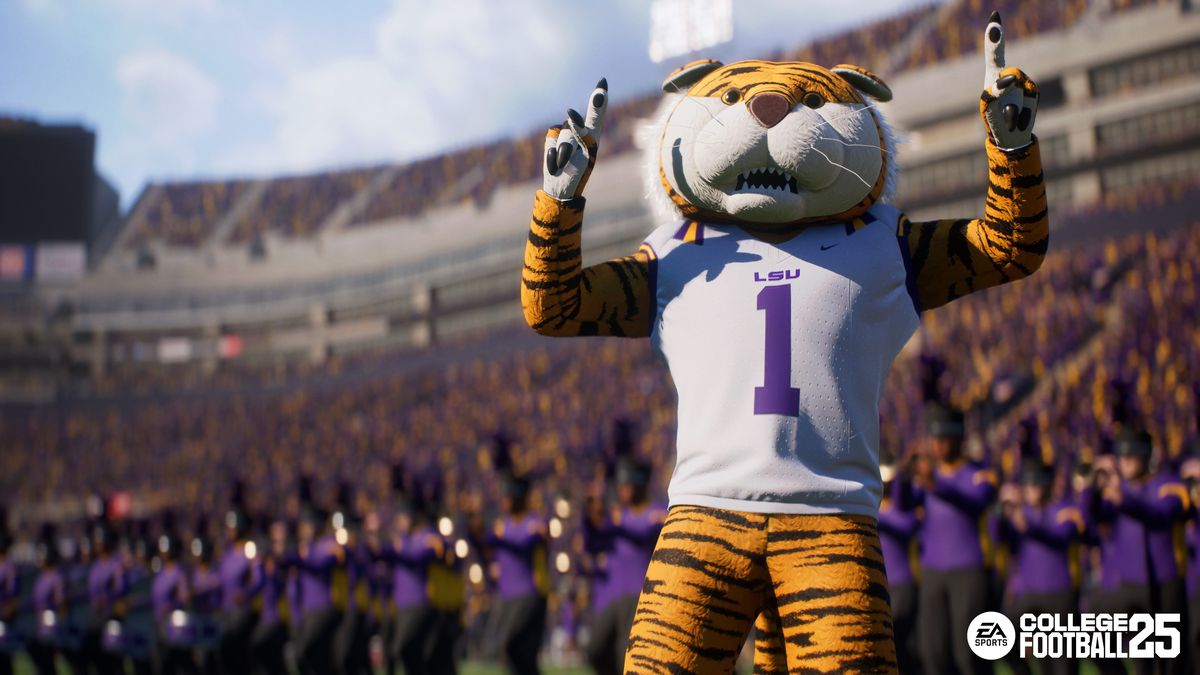
So much of what makes college football, college football, is the environment in which it’s played: the stadiums, the crowd chants, the uniforms, mascots, and everything else that goes into making game day a little bit different at each of the 134 FBS schools in the game.
Thanks to open records requests and regular ol’ phone calls, I’ve reported extensively over the last several years on how EA, and the individual schools, have sought to digitally re-create those experiences. Schools submitted dozens of audio files, from what they play on third downs to what non-R-rated chants their students yell to what riffs their marching bands play. EA asked for hundreds of stadium photographs from every conceivable angle, as well as locker room shots and seating charts, so the game’s developers could more accurately render everything from the exact location in which the opposing band sits to what the tunnel walk into each team’s stadium looks like.
EA didn’t nail this every single time. There are a few stadiums whose recent renovations were missed; most mascots outside the biggest brands aren’t included; and some uniforms and logos are imperfectly rendered. It doesn’t appear that EA opened its wallet to license very many songs, so iconic college football traditions like Wisconsin’s “Jump Around,” or “Enter Sandman” at Virginia Tech, aren’t included. The lack of a robust music library means that you’re going to hear “Mo Bamba” a lot during games, and the drumline-only soundtrack during menus even more than a lot. (I’m a former band geek drummer myself. I love me some cowbell and marching snares. But even I had to mute the music sometimes.)
But on the whole, I think EA did an excellent job. Team-specific turnover stunts, like a turnover throne? In the game. Teams singing the alma mater to the crowd after the 4th quarter ends? In the game. Minnesota’s mascot rotating his head in a complete 360, like out of some horror movie? In the game. The list goes on.

The attention to detail isn’t just about the school-specific stuff, but about College Football 25’s presentation of the game of football itself. If you look down the sidelines before you snap the ball, you can see assistants holding up massive play call placards, just like they do during real games. You’ll see your quarterback glance toward the sideline if you change the play call at the line of scrimmage. If you rip the heart out of the home crowd, you’ll see fans doing the surrender cobra. The game includes two different broadcast teams who recorded tens of thousands of lines of commentary, as well as studio cut-ins, which adds to the immersion. It’s very easy to feel like you’re playing in a major broadcast window, even if you’re playing Wyoming at East Carolina.
The common concern I heard from other fans for months, if not years, leading up to this game’s release was the worry that EA would simply make College Football 25 a “Madden reskin” — essentially, a rerelease of its NFL game, only with Nebraska and Alabama uniforms.
Are there similarities? Of course. It’s still football, and both games are made by the same studio and have shared staffers. But I can conclusively state that the games play and feel very different.
This game also feels very different from NCAA Football 14, and anybody expecting to simply import all of that built-up muscle memory and dominate from the first snap is in for a rude awakening.
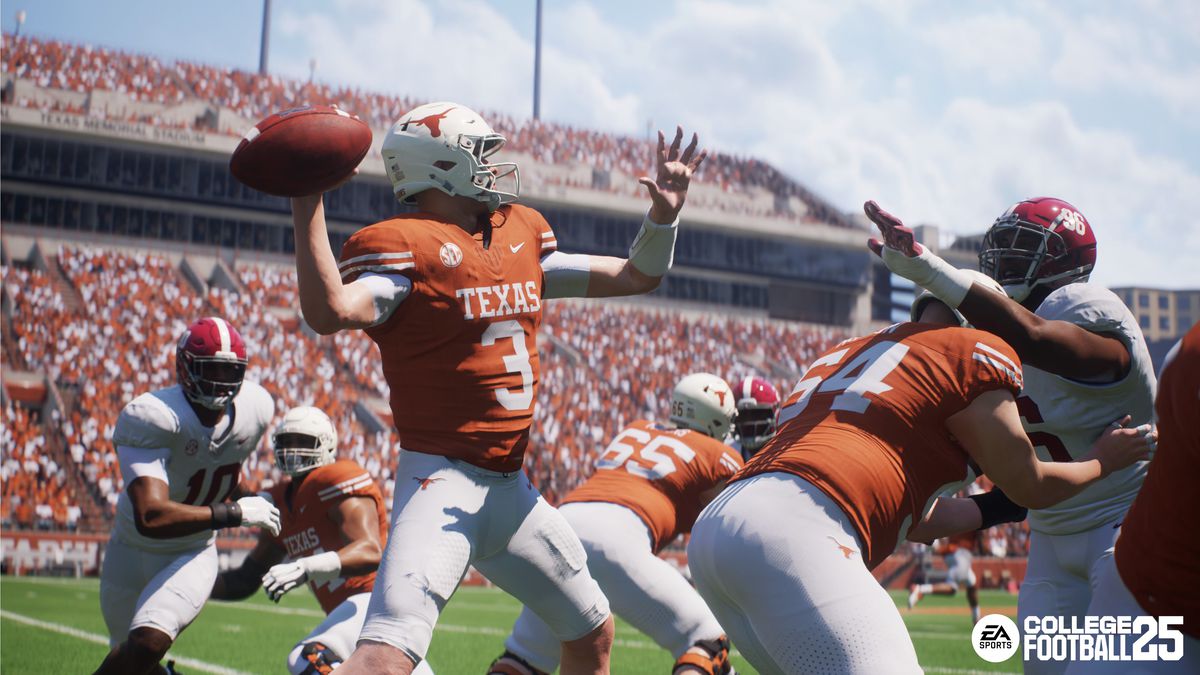
In my experience, this year’s college football game is a lot harder than NCAA 14. For one, the passing system has been completely revamped, with the game putting a huge emphasis on properly “layering” the ball in coverage. Each pass has a blue/yellow/red meter, depending on the QB rating, the pressure, and the angle and type of pass thrown. If you hold the button down too long, trying to throw a bullet pass, your accuracy will take a major dive. The pass you end up throwing might still be catchable, but the wideout might need to break stride to grab it, turning what should be a walk-in touchdown into merely a big gain.
Consider the following example that I experienced numerous times over my first 20 hours. A quarterback drops back to pass to a wideout running a post route. In a perfect world, the QB throws the ball over any lurking linebackers and hits the receiver juuuust in front of him, so he can catch the ball in stride. Even if my receiver was open, if I pushed the button too lightly, the ball might “float” too much, allowing the defender to catch up to his man and break up the play. Throw the ball too low, and the linebacker could pick off the pass. If I didn’t hit the meter perfectly, maybe my guy would catch the ball and immediately trip over himself and falls down.
It takes a lot of practice. You can make the right decision, get your guy open, and still easily mess up the pass. It can be frustrating if you’re expecting to instantly run a competent Air Raid offense, but I mostly appreciated the challenge. It makes completed big plays feel even more like an accomplishment.
Running the ball has also changed. The AI around blocking schemes has improved, and new animations and physics make it easier to fight through arm tackles or poor pursuit angles. The option system has also been revamped. The good news is that players now have multiple types of pitches they can throw, which can open up the playbook beyond the commonly used Read Option. The bad news is that the button scheme to hand the ball off or keep it has flipped from the last few years, meaning that I spent hours handing off the ball when I meant to hold on to it.
The new mechanics on offense take time to practice, but they’re not totally inaccessible. Defense, however, feels much harder. In my very first game, I played my beloved alma mater, Ohio State (one of the very best teams in the game), and took them on the road to play a middling BYU squad, my wife’s alma mater. I gave up 49 points with five-minute quarters, as the Cougars ripped off multiple 50-plus-yard touchdown bombs. Figuring out how to switch to the right defender, how to take the proper pursuit angle, and that I shouldn’t Hit Stick on every opportunity was not easy.

I’ve gotten a little better at playing against the AI, but online, I still haven’t cracked the code on playing effective defense, and I’ll give up 250-plus rushing yards to virtually any competent opponent. I’ve found that if I’m not forcing a turnover, getting consistent stops takes practice, a good eye… and probably a little luck.
College Football 25 offers five main game modes: Play Now, Dynasty, Road to Glory, Ultimate Team, and Road to the College Football Playoff. Road to the CFP is the game’s ranked online play system, and is the mode that I’ve played the least. I’ve spent the bulk of my time in Dynasty, RTG, and Ultimate Team.
Dynasty has been the bread and butter of EA’s college football series for years. Here, players can create their own coach, hire a coaching staff, set their schedule, recruit players, and take over a college football program.
One area where EA clearly tried to add complexity and depth is with coaching skills. Just like in previous years, coaches can level up and add new skills by completing certain recruiting or in-game goals. But in previous editions, just about everybody would beeline to trying to max out their coach recruiting tree. In practice, there was really only one way to build your coach, and after a few seasons, you could fill out the entire skill tree.
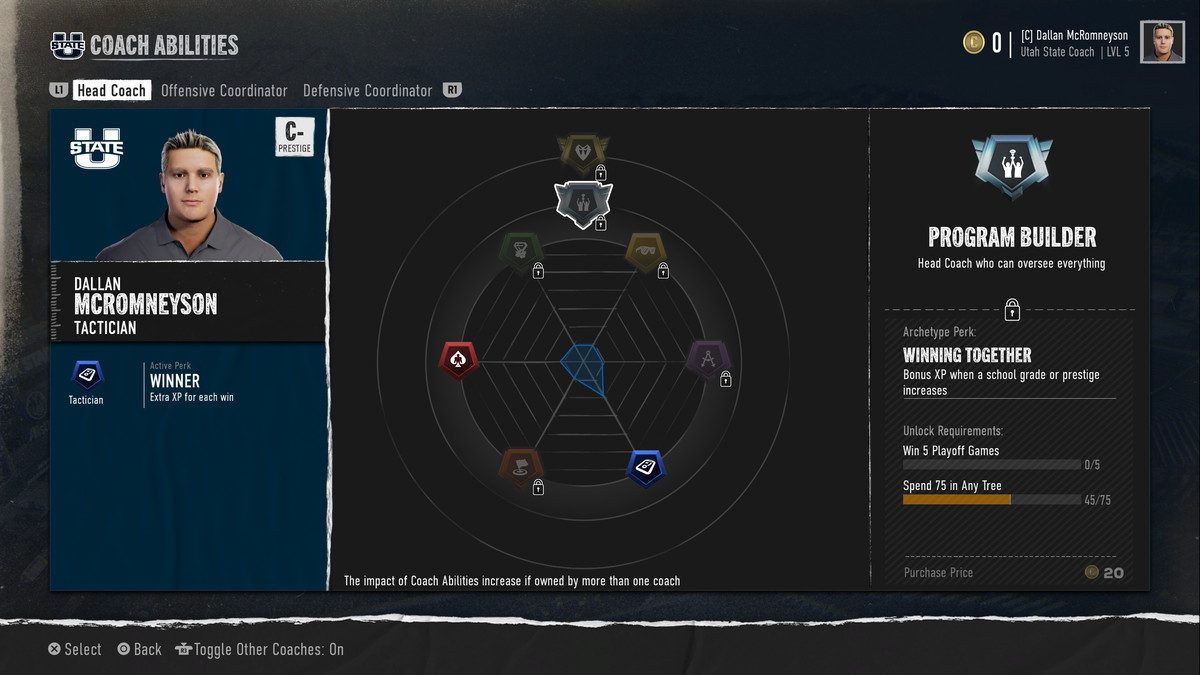
Now players can pick between different coach archetypes, like a master recruiter, tactician, or motivator, while blending skills from different trees. You can also hire coordinators, who have their own skill trees, leaving you to decide if you want to double (or triple) down on your strengths, or build out a more balanced staff. I actually found the nonrecruiting buffs like tactician to be very helpful when turning around underdog programs, and I love that there are now multiple ways to approach running a program.
Recruiting is substantially deeper than in previous years. Users will need to allocate time to not just scout individual recruits, but also to determine what sorts of things the athletes are interested in, like playing time, campus environment, and coach prestige. The process makes it much easier to become attached to certain recruits, and winning a tough battle feels more rewarding. But it’s also way harder to recruit athletes to lower-profile schools than it was in previous years. It doesn’t matter if you go 9-3 and win the Who Gives a Crap Bowl with your MAC program in year one; you aren’t signing more than maybe one four-star recruit out of high school right off the bat. Just like in real life.
The recruiting system grapples with a critically important question in college video game design: Where is the line between realism and fun? In real life, if users had to manage a roster exactly the same way coaches at Power Four institutions do, they’d absolutely hate it. They’d hate the shady payroll management via outside collectives, hate the babysitting of 19-year-olds, hate needing to send a gazillion texts to teenagers, the whole thing. This game simplifies some systems in a nod to preserving the fun, even if some die-hards would probably wish for a more Football Manager-like simulator.
If I had one early critique of my time in Dynasty, it’s that the computer doesn’t do a great job simulating other results. In my most recent Dynasty (where I created a coach named Dallan McRomneyson to take over Utah State), Notre Dame, Florida State, and Clemson all started out 0-2. High-profile teams probably lose a little too often right now, which I’ve seen lead to some pretty funny College Football Playoff scenarios. UMass Minutemen, you are a College Football Playoff participant! Georgia Bulldogs, get ready for the Autozone Liberty Bowl!
Road to Glory is a faster-paced mode, allowing the user to take over the career of a college athlete, as you balance academic, social, and athletic pursuits. I know many fans were sad to learn that EA removed the high school football component of the mode, but I actually enjoy the change. You can complete an entire career in under 20 hours, and the resource management mode (which requires everybody to make some trade-offs), plus a large library of scenarios (complete with weighted-dice-roll randomized answers), means that no two playthroughs are the same.
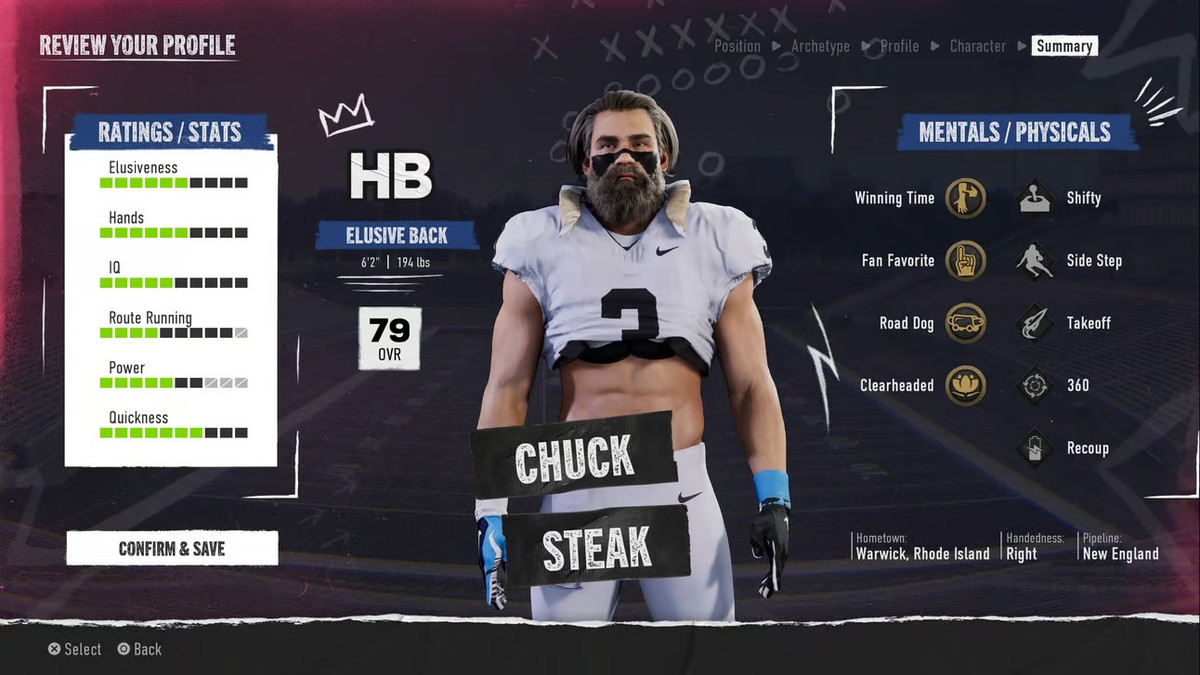
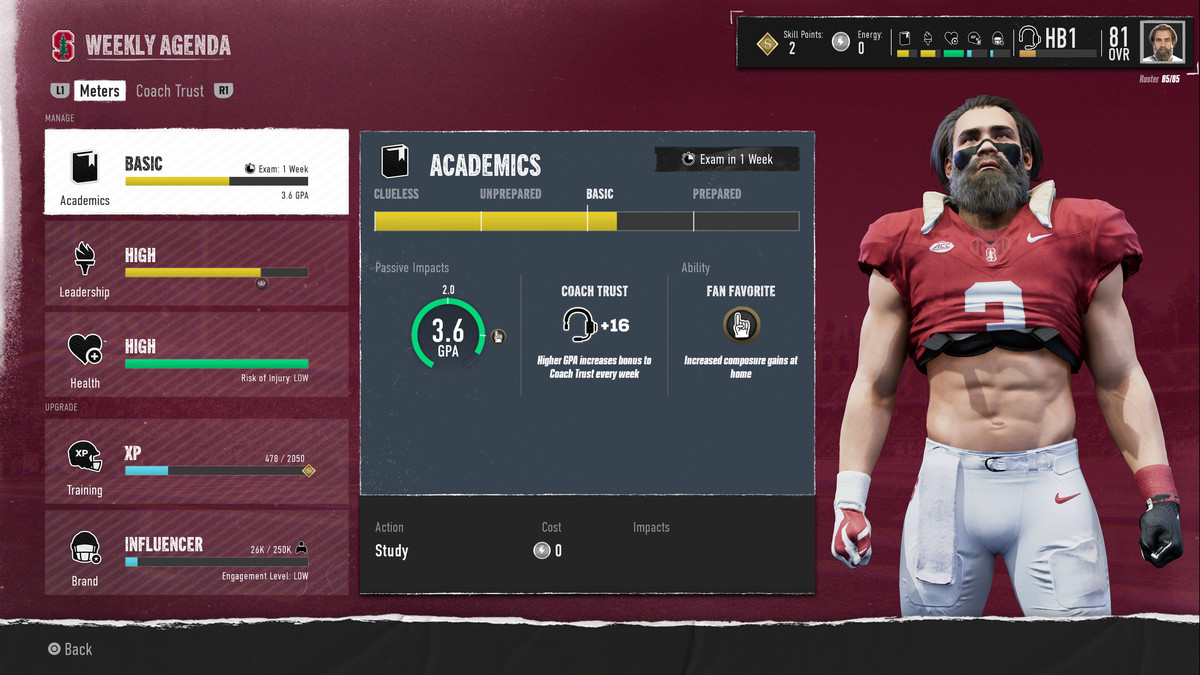
I started with a five-star running back out of Rhode Island who I named Chuck Steak. I decided to send him to Stanford, where he’d have a chance to start right away, but would also need to spend a legitimate amount of time focusing on school to stay academically eligible. The pacing of the player progression system doesn’t allow you to make some 99-overall mutant by week 7 of your freshman year, but you can put up some huge numbers as an upperclassman if you can stay healthy.
The gameplay can be frustrating if you’re not on a great team (good luck throwing the ball without an offensive line!), or if you don’t have great coach trust (good luck being a quarterback if your coach calls nothing but handoffs!), but that’s also realistic. It turns out, you generally can’t play like Broken Leg Greg Jennings very often in real life.
I’ve actually been pleasantly surprised with Ultimate Team, although I completely understand if other people are decidedly uninterested in the mode. I found it was an excellent introduction to the new playbooks and game mechanics, giving users a chance to run quick challenges to familiarize themselves with the differences between the Air Raid and the Veer and Shoot. With a large selection of single-player options and a massive base of potential cards — the mode includes not just current college football stars, but NFL players and historic college legends as well — there’s a lot of potential.
I did not feel any immediate need to buy cards or points in order to complete any single-player objectives, but I also have no designs on being a competitive online player. Like with any other AAA sports title’s Ultimate Team mode, I imagine it will be very difficult, over the course of the year, to be a competitive online No Money Spent player.

College Football 25 isn’t perfect. But neither is real-life college football.
I don’t love college football because I think it’s a perfectly well-oiled, efficient machine. It isn’t! The sport is terribly governed, faces a multitude of existential challenges, and sometimes produces glitchy, even unwatchable, results.
But it’s beautiful and fun in spite of the warts and glitches — because it’s ours. I didn’t go to the Chicago Bears; I went to Ohio State. I rang the victory bell. I sat in that press box. I feel a tiny stirring within myself whenever I see the Dotting of the I, because of the deep connection that institution has to my own personal history.
Fans haven’t just wanted to play a football simulation with a team that wears Scarlet and Gray uniforms instead of Orange and Brown ones. They’ve wanted to replicate that connection. And here, I think EA Sports College Football 25 delivers the goods.
Again, it isn’t a perfect video game. I imagine some of its shortcomings, like the missing uniforms, assorted display bugs — all the players in Ultimate Team, for example, show up as being from Alabama, even though they get the player’s hometown correct (which is kinda funny, if immersion-breaking) — and other stuff will get patched relatively quickly. Other quirks, like the simulation logic or defensive AI, might take longer to fix. It isn’t hard to think of plenty of new stuff the dev team could add to next year’s game.
But this game is also very clearly a labor of love from developers who deeply care about college football and college football culture. It’s a testament to what is possible with sports games when teams have longer than a few months to crank out AAA titles. And if this is the foundation for future college football games, then the series is in a very, very good place.
Would I have liked to have college football video games over the last decade? Of course. But this edition?
This was worth the wait.
EA Sports College Football 25 was released July 19 on PlayStation 5 and Xbox Series X. The game was reviewed on PS5 using a pre-release download code provided by EA. Vox Media has affiliate partnerships. These do not influence editorial content, though Vox Media may earn commissions for products purchased via affiliate links. You can find additional information about Polygon’s ethics policy here.
Matt Brown is the publisher of Extra Points, a newsletter covering business, policy, and off-the-field stories in the college sports industry. He has extensively reported on the development of EA Sports College Football since 2021, so much so that EA put his dang name in the game’s credits. He was previously the associate director of college team brands at SB Nation, which was a good website. He lives in Chicago.
